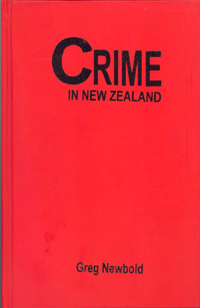Subtotal: 0.0
In 1991 when I was researching a previous publication, Crime and Deviance, there was a dearth of information about the profile of criminal offending in New Zealand. The last comprehensive survey on the subject had been published in 1968 and the most recent Justice Statistics, published by the Department of Statistics, were for 1988. In 1991, these annual figures ceased being published as well. It was becoming increasingly difficult to obtain up-to-date material about crime and criminal justice.
Since then, things have changed considerably. In late 1991 the Department of Justice (part of which became the Ministry of Justice in 1995) started publishing detailed information about the conviction and sentencing of offenders over the previous decade, which is updated every year. There is thus now an unbroken series of data going back to 1981. In addition to this, the Ministry of Justice has released a number of informative booklets dealing with topics such as prison censuses, prison population forecasts, victimisation surveys, and analyses of legal and policy initiatives. In 1996 Statistics New Zealand published a useful summary of crime in New Zealand over the past two decades, and there have been a number of valuable academic publications as well.
These texts, in addition to annual reports of the police and the Department of Corrections, are vital resources to the criminologist and allow almost up-to-the-minute monitoring of some offending trends. Other areas, however, such as certain types of drug offending, white-collar crime, organised crime, and ethnic and gender-offending differences are not carried in official statistics and require more intensive research or access to unpublished information from official sources. This information provides some of the most interesting detail in this book and allows a novel interpretation of several crime-related areas.
Crime in New Zealand updates and expands the information that appeared in Crime and Deviance in 1992. In addition it records and discusses the numerous developments that have taken place since then. For example, it looks at the sharp increases in crime commencing in the 1960s and 1970s that have now levelled out or begun to decline. It examines many of the legislative changes, particularly in the areas of domestic violence, the conduct of sexual violation trials and violent offending generally. It shows how patterns of drug offending have altered, with methamphetamine and ecstasy and a revival in the popularity of LSD making significant inroads in New Zealand. Organised crime - conducted by ethnic Asian gangs, street and motorcycle gangs is another area that is looked at, together with the policy and legal initiatives put in place to combat it. More information about domestic violence is available now than was the case in the early 1990s and compelling figures show that Maori and Pacific peoples predominate in all forms of reported violence. Finally, where criminal justice is concerned, strong reasons are given that men, compared with women, are disadvantaged by the criminal justice process. There is also evidence that a number of individuals serving time in New Zealand prisons may be innocent of the crimes for which they were convicted.
Crime in New Zealand looks at contemporary and recent offending and criminal justice patterns and analyses them in an objective and critical way. It considers the rises, falls and distribution of reported offending and tries to explain them in terms of social, political and economic factors. The book sometimes tramples over popular notions about sex, gender, ethnicity and drugs, but it does so in a way that draws upon data, research and argument in the conclusions it offers. In so doing it may offend the sensitivities of some. The affront is not intentional but neither is it regretted. One of my objectives in this book is to critique conventions that, because people see them as sacred or take them for granted, are seldom debated.
As is always the case with books of this type, it could not have been written without the significant help of others. A lot of the information that appears in the text has not been published before and I am indebted to a number of workers, too many to mention by name, in the Department of Corrections, the Ministry of Justice, the Department of Child, Youth and Family Services, the New Zealand Police, the New Zealand Customs Service, the Serious Fraud Office, Pharmac, Work and Income New Zealand, and the National Collective of Independent Womens Refuges, for providing valuable material and advice that I could not have done without. I am also grateful to several people who took the time to read and comment on chapters in their current form or in earlier drafts. In particular I would like to thank Bernie Brown, Tracy Cormack, Catherine Cull, Merv Cull, Api Fiso, Bill Hodge, Samantha Jeffries, Allison Morris and David Thorns. I also extend my warm thanks to Antoine Monti for the fine work he did on the figures, and to Scott Optican for scrutinising the entire script and providing a detailed, incisive and professional review. Finally I thank Sharmian Firth and the Dunmore Press team for their excellent editing of the manuscript.
I dedicate this book to my close and loyal friends, Geoff and Joy Harding.
Preface
Chapter 1: Crime, Deviance and Social Control
Chapter 2: Property Crime
Chapter 3: Womens Crime
Chapter 4: Sexual Deviance
Chapter 5: Violence
Chapter 6: Drugs
Chapter 7: Organised Crime
Chapter 8: Justice and Injustice
Chapter 9: Crime, Injustice and Inequality Appendix : Crime in New Zealand - Factsheet
Index


Please Login To Write A Review
Login